Animals in the clouds: exploring deep-time landscape &
art of the Biennale Gherdëina
The Biennale Gherdëina is scattered across the town of Ortisei,
the Val Gardena & various valleys & moments of picturesque nature
between. Curated by Lorenzo Giusti, it is a biennial interested in the deep history
& long future of the region, open to creative ideas for coexistence with
nature & animals. Will Jennings went along with photographer Carlo Zambon to discover that through installations, exhibitions & performances the project
makes poetic & provocative conversation with its setting.
There are well over 300 art biennials across the world.
Usually these are urban affairs, like the first and most well-known, the Venice Biennale, offering the public a way to explore cutting edge culture, the city, and the unique
way the two can interact. Sometimes, however, a biennial is located across a wider
landscape, and this is the case with the 9th Biennale Gherdëina held
across a valley in the Dolomites, northern Italy.
Over winter months, the ski resorts of Val Gardena attract tourists from across Europe, while over summer months the mountains offer the opportunity to walk into the clouds. The biennial was initiated in 2008 as a fringe event of the nomadic European art and architecture biennial Manifesta, for the first time covering a whole region between South Tyrol and Trentino. In the editions since, it has grown into a project celebrating the landscape and vernacular of the region, with each edition finding its own way to intersect with the history, industry, and communities around the central town of Ortisei/Urtijëi.
The reason for the town having two spellings of its name is rooted in their being two local languages: Italian and Ladin. Spoken by up to 40,000 people as a first language in rural areas of northern Italy, Ladin, it is spoken more as a preservation of historic community and very much an active element of the place’s identity and directly informs the curation of the biennial.
The biennial’s subtitle, The Parliament of Marmots, is derived from a nearby mountain valley, the location that local Ladin myth says the surviving members of the local Fane community lived with the population of Marmots after the decline of their kingdom was brought about following a princess’ embarrassment of her people’s pact with animals that ensured mutual prosperity.
Over winter months, the ski resorts of Val Gardena attract tourists from across Europe, while over summer months the mountains offer the opportunity to walk into the clouds. The biennial was initiated in 2008 as a fringe event of the nomadic European art and architecture biennial Manifesta, for the first time covering a whole region between South Tyrol and Trentino. In the editions since, it has grown into a project celebrating the landscape and vernacular of the region, with each edition finding its own way to intersect with the history, industry, and communities around the central town of Ortisei/Urtijëi.
The reason for the town having two spellings of its name is rooted in their being two local languages: Italian and Ladin. Spoken by up to 40,000 people as a first language in rural areas of northern Italy, Ladin, it is spoken more as a preservation of historic community and very much an active element of the place’s identity and directly informs the curation of the biennial.
The biennial’s subtitle, The Parliament of Marmots, is derived from a nearby mountain valley, the location that local Ladin myth says the surviving members of the local Fane community lived with the population of Marmots after the decline of their kingdom was brought about following a princess’ embarrassment of her people’s pact with animals that ensured mutual prosperity.

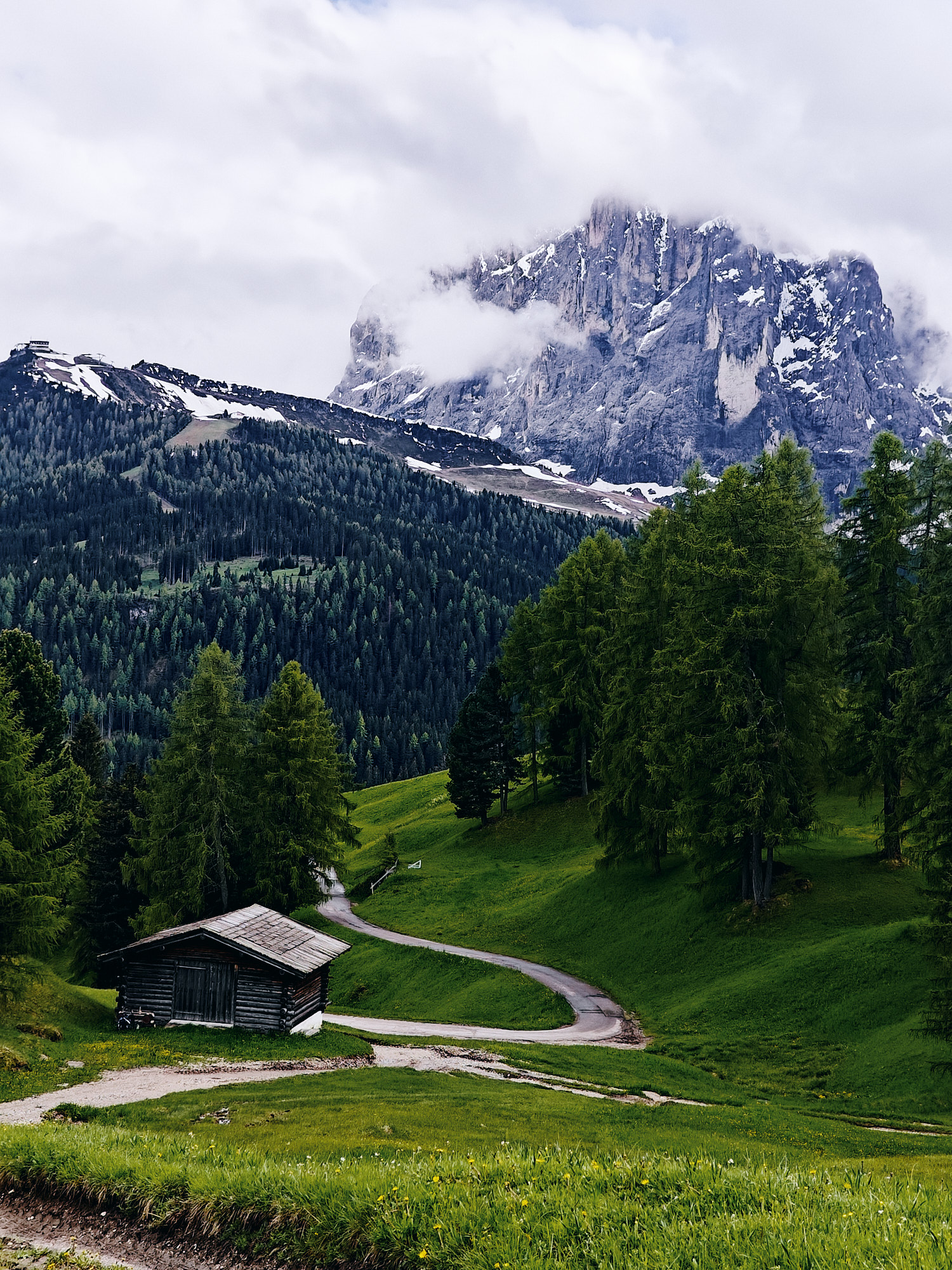

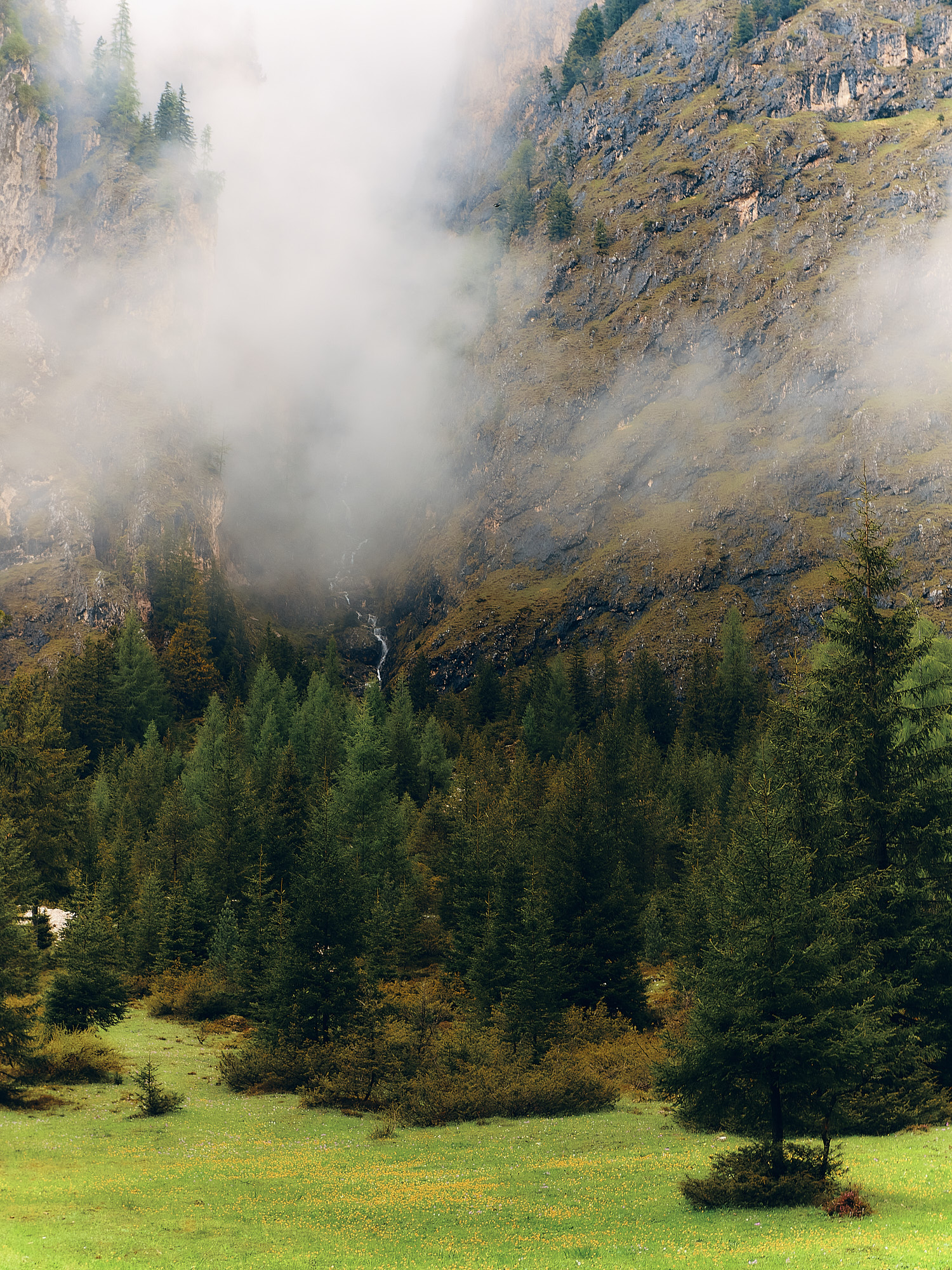
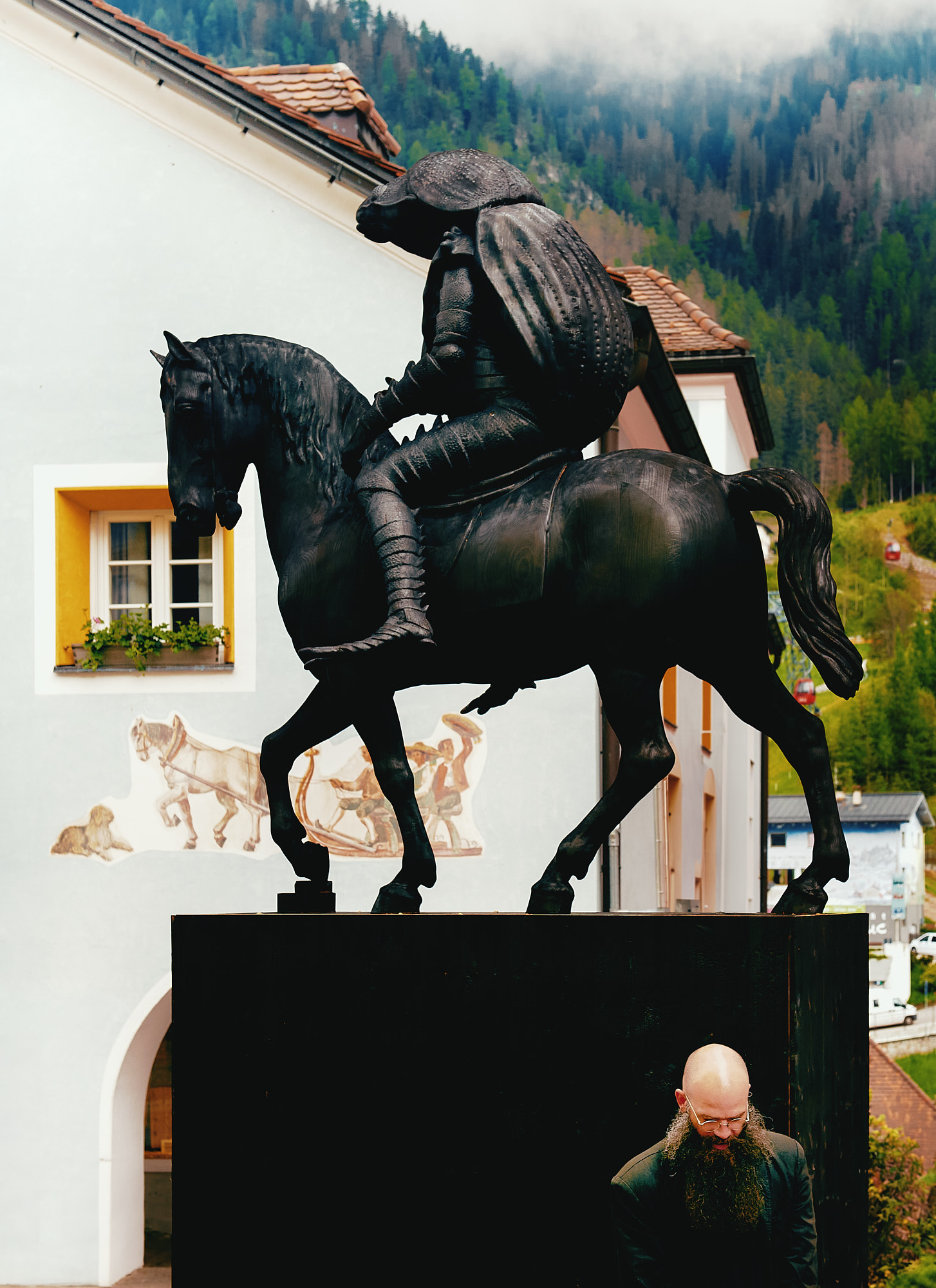
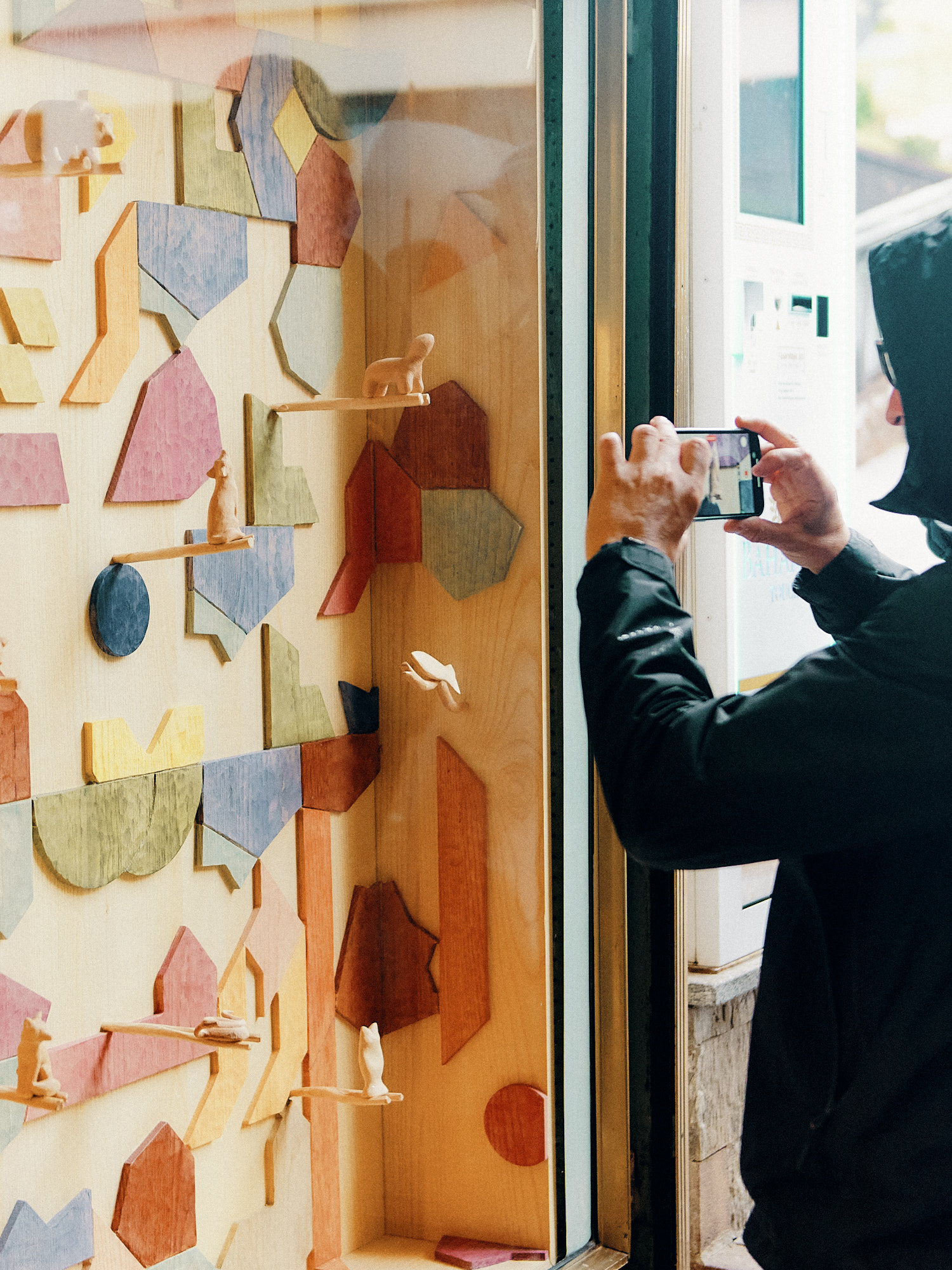

In the centre of Ortisei an animal takes pride of place,
though somewhat provocatively. Beetle on a Horse by Julius von Bismarck
takes the form of a ceremonial equestrian statue, but with a bark beetle rather
than white male human riding the steed. Carved out of wood – a local craft
industry – it has been burnt to a blackness, while in the distance the trees of
the Dolomites mountainside can be seen. Dark brown patches can clearly be seen
in the mass of green, swathes of tree death caused by the beetle that thrives
in the densely overplanted commercial forests. Von Bismarck here presents the
beetle as a conqueror, at the centre of a population who work with trees and
wood but have perhaps lost the balance of coexisting with nature.
Nearby in a dark semi-basement straight off the high street, roots seem to be growing through a concrete floor with Nadia Kaabi-Linke’s installation Mushroom. A terrain of trip hazards, visitors are forced to move tentatively and carefully through a space which speaks to different modes of time and construction – that of quick architecture of humans, and the slower undulating roots of nature.
Esraa Elfeky presents a series of butterfly drawings on paper through the Museo de Gherdëina and Moroccan-French artist Sara Ouhaddou has collaborated with local wood craftswoman Helene Demetz to create small wooden animal sculptures referencing zoomorphic pottery of the Atlas Mountains since the Neolithic period.
Nearby in a dark semi-basement straight off the high street, roots seem to be growing through a concrete floor with Nadia Kaabi-Linke’s installation Mushroom. A terrain of trip hazards, visitors are forced to move tentatively and carefully through a space which speaks to different modes of time and construction – that of quick architecture of humans, and the slower undulating roots of nature.
Esraa Elfeky presents a series of butterfly drawings on paper through the Museo de Gherdëina and Moroccan-French artist Sara Ouhaddou has collaborated with local wood craftswoman Helene Demetz to create small wooden animal sculptures referencing zoomorphic pottery of the Atlas Mountains since the Neolithic period.
This edition of the Biennale Gherdëina is curated by Lorenzo
Giusti, the director of Bergamo’s GAMeC – Gallery of Modern Art and Contemporary
Art. recessed.space recently featured his GAMeC project, Thinking Like a
Mountain (see 00208)
and there is overlap with his conceptual framing there and the biennial here.
The GAMeC exhibition of the work of Lin May Saeed, born into a German-Jewish family in 1973 but who sadly passed away in August 2023, continues with a second part in Ortesie. Presented as a tribute to the artist, there are countless animals within gallery of the Kulturhaus Luis Trenker, formed as reliefs and sculptures made of polystyrene.
Saeed initially used the material due to its affordability and ubiquity, but carried on developing it after art school, interested in its unnatural petrochemical creation, fragility of form, and durability in regards to climate. Across the works on show here, animals are freed from their cages as works of hope, with fairytales, myths, and texts woven into narrative-laden reliefs.
The GAMeC exhibition of the work of Lin May Saeed, born into a German-Jewish family in 1973 but who sadly passed away in August 2023, continues with a second part in Ortesie. Presented as a tribute to the artist, there are countless animals within gallery of the Kulturhaus Luis Trenker, formed as reliefs and sculptures made of polystyrene.
Saeed initially used the material due to its affordability and ubiquity, but carried on developing it after art school, interested in its unnatural petrochemical creation, fragility of form, and durability in regards to climate. Across the works on show here, animals are freed from their cages as works of hope, with fairytales, myths, and texts woven into narrative-laden reliefs.





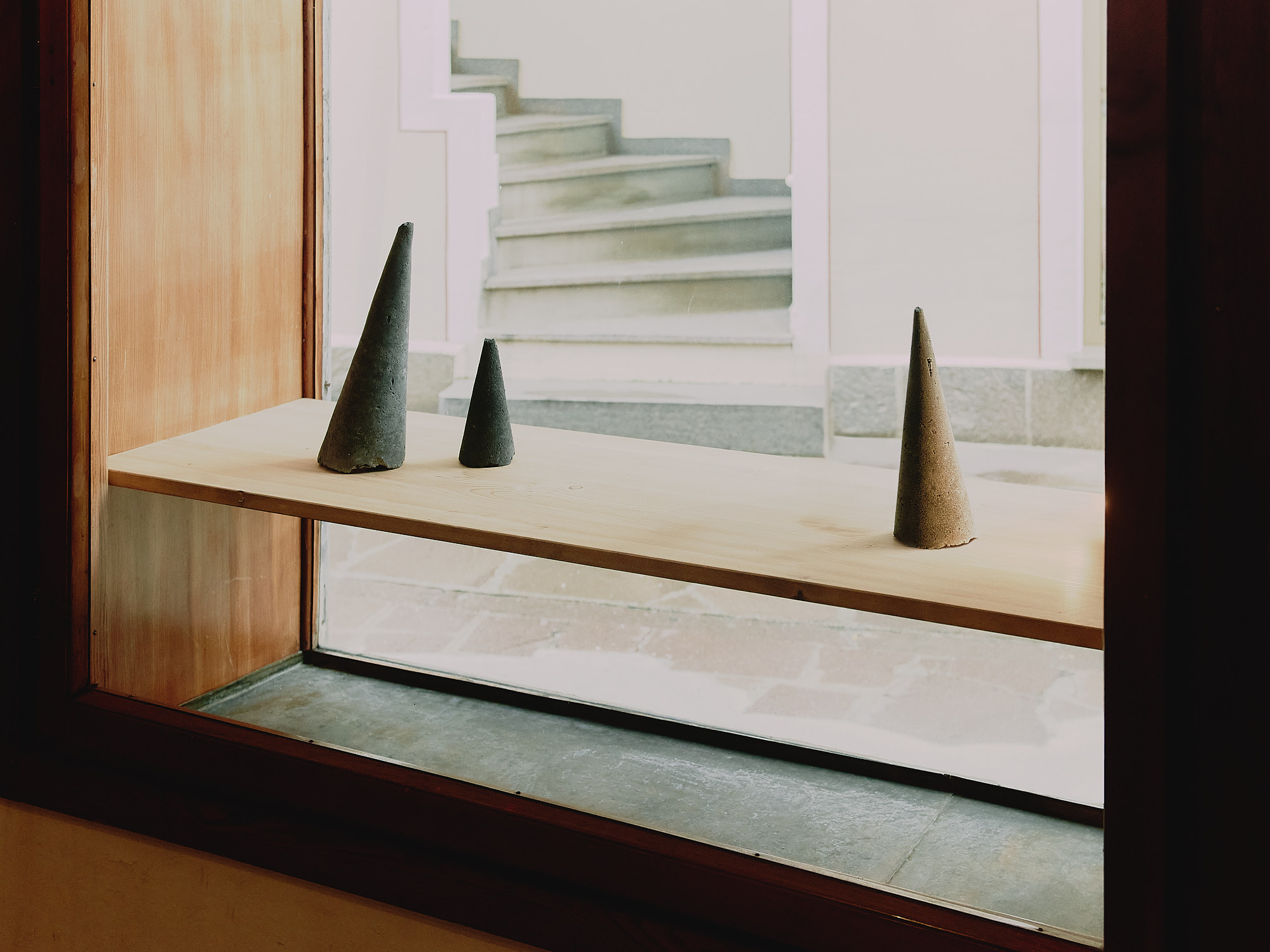
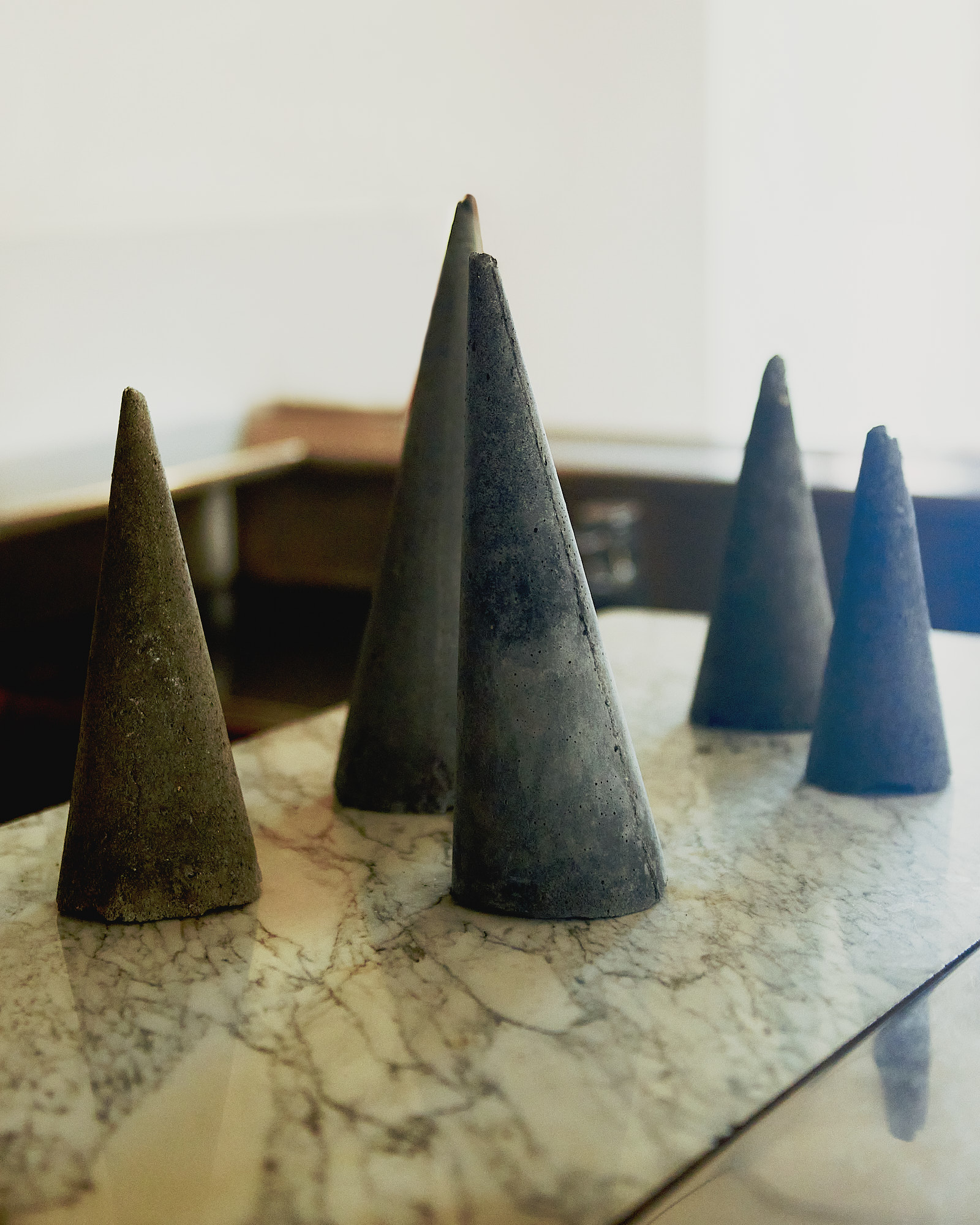


The ground floor lobby and café space of a long-closed hotel
in Ortisei hosts a number of artists, with its outside transformed into a
colourful clash of geometry by artist Nassim Azarzar. Their mural shouts into
the street, bringing attention to an already handsome deco frontage, the forms
and colour derived from ongoing research into ornamentation and aesthetics of
trucks working the highways of Morocco.
Inside, within the former café of Hotel Ladinia’s wood-filled ground floor, are conical sculptures made by former economist Alessandro Biggio. Formed of burnt wood, the Ash Cones are part of an ongoing series in which the artist is experimenting with fragility and permanence, something also present in a parallel video work capturing frames from films of mountain landslides.
Mountains are never far away in Ortisei, and neither are they in this room with Daniele Genadry also tackling them with her painted, graphic works. Derived from a photographic image, Genadry paints overexposed mountains with bright, monochrome palettes in a delicate reflection of their monumentality. There are questions here around perception and legibility, as well as taking nature for granted and not always seeing that which is present.
Inside, within the former café of Hotel Ladinia’s wood-filled ground floor, are conical sculptures made by former economist Alessandro Biggio. Formed of burnt wood, the Ash Cones are part of an ongoing series in which the artist is experimenting with fragility and permanence, something also present in a parallel video work capturing frames from films of mountain landslides.
Mountains are never far away in Ortisei, and neither are they in this room with Daniele Genadry also tackling them with her painted, graphic works. Derived from a photographic image, Genadry paints overexposed mountains with bright, monochrome palettes in a delicate reflection of their monumentality. There are questions here around perception and legibility, as well as taking nature for granted and not always seeing that which is present.
Up the road, Ruth Beraha presents a sound installation within
a disused theatre, a crescendo of birdsong starting with a simple, sweet call
and ending with cacophony. One of these birds appears to have escaped and flown
into Hotel Ladinia, the artist placing the back half of a single ceramic bird,
seemingly stuck between the room and the wall, perhaps trying to return to some
place or some time.
Seemingly also searching for something is Michael Höpfner, an artist who starts his work with a walk. Carrying an analogue camera, Höpfner walks towards distant, unspoilt natural territories looking for a connection to place and past. The work in Hotel Ladinia began with walks across the South Tyrol Dolomites, thinking of the mountain ranges as a rhizome, drawing from George Deleuze and Félix Guattari’s 1980 book, A Thousand Plateaus. The outcome is an interconnected mesh of knots and strings, wrapped around rocks and rooted to itself. On the walls, silver gelatine prints and drawings offer another mode of capturing vastness, distance, and movement.
Seemingly also searching for something is Michael Höpfner, an artist who starts his work with a walk. Carrying an analogue camera, Höpfner walks towards distant, unspoilt natural territories looking for a connection to place and past. The work in Hotel Ladinia began with walks across the South Tyrol Dolomites, thinking of the mountain ranges as a rhizome, drawing from George Deleuze and Félix Guattari’s 1980 book, A Thousand Plateaus. The outcome is an interconnected mesh of knots and strings, wrapped around rocks and rooted to itself. On the walls, silver gelatine prints and drawings offer another mode of capturing vastness, distance, and movement.








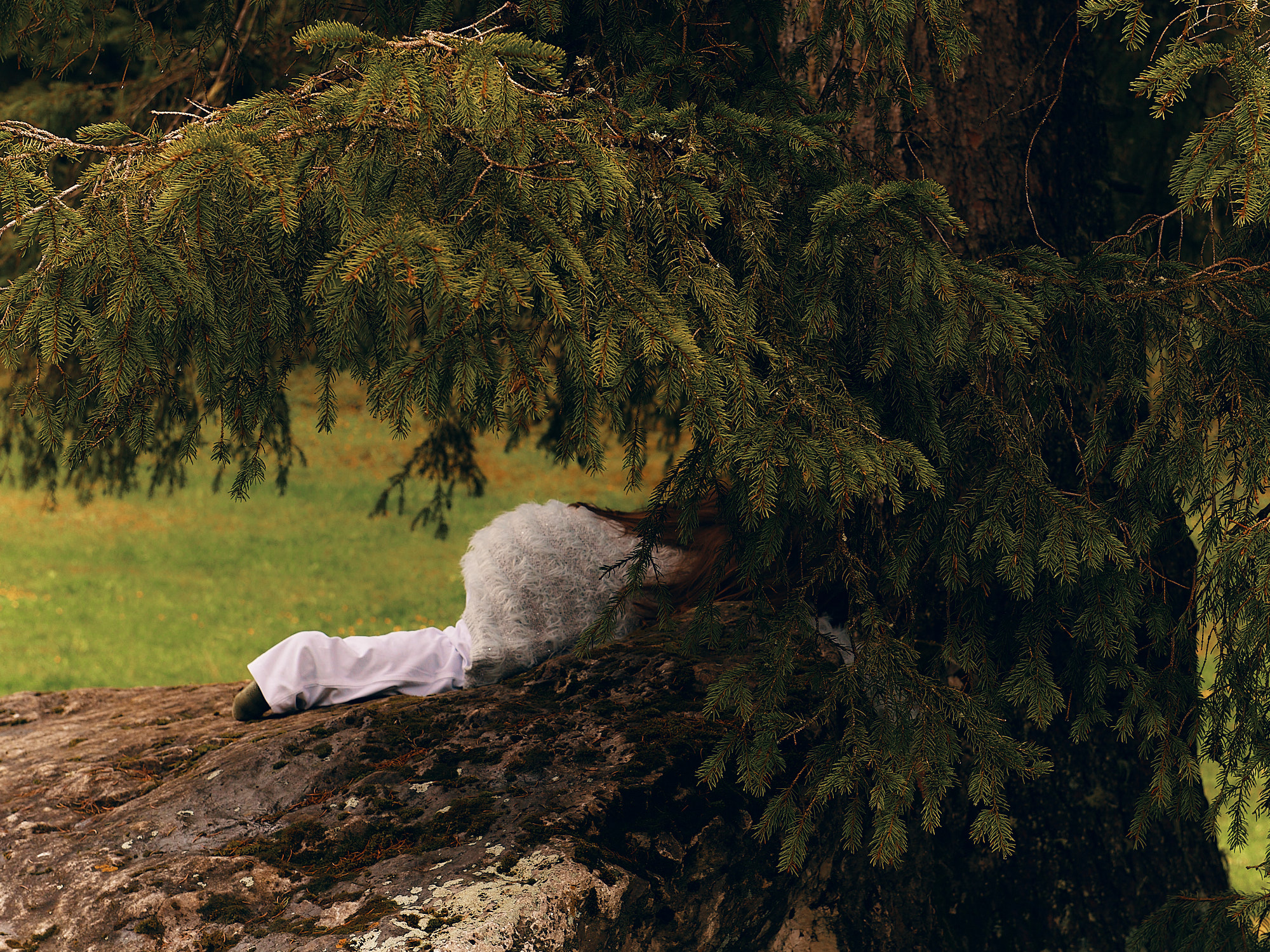
Performance and site-specificity pop up across the Biennale Gherdëina
– and sometimes the sites are special. Italian performer and artist, Chiara
Bersani, presented a performance in the majestic valley of Vallunga, where
rocky outcrops puncture misty skies. On a boulder, Bersani performed a version
of L’Animale, a work riffing off Anna Pavlova’s Dying Swan, presenting as a
creature between human and animal, life and rest. Bersani has the brittle bone
condition of osteogenesis imperfecta, her movements and calls on the rock are
careful, calculated, and existential.
Somewhat less intense, but also requiring a walk through nature to reach, are Arnold Holzknecht’s two timber wolves. A sculptor who has turned to the carving techniques of the local area, he has created a black and white wolf as a conversation starter around the reintroduction of the animal to surrounding forests. Wrapped in sheep wool, the creatures come across as friendly, inquisitive, and will likely be used by children and adults as seats across the biennial’s duration, perhaps also softening local arguments around the policy.
Somewhat less intense, but also requiring a walk through nature to reach, are Arnold Holzknecht’s two timber wolves. A sculptor who has turned to the carving techniques of the local area, he has created a black and white wolf as a conversation starter around the reintroduction of the animal to surrounding forests. Wrapped in sheep wool, the creatures come across as friendly, inquisitive, and will likely be used by children and adults as seats across the biennial’s duration, perhaps also softening local arguments around the policy.
Fischburg Castle is host to a number of sculptural works and
a high vantage from which to watch performances in the distance. Diana
Policarpo’s Anguane’s Fountain sits at the centre of the courtyard as if
a sponge from the ancient, deep ocean has ruptured through one of the mountains
its ancestors formed hundreds of millions of years ago.
Femmy Otten, an artist interested in the human body, has three pieces up here that fold bits of the flesh into Linden Wood forms. An hourglass shape carries ears, noses, and faces in a suggestion of cyclic endlessness. In the corner of the castle walls an oversized vulva seems to grow from the stones in a fungal way.
At the biennial’s opening, in pouring rain, Linda Jasmin Mayer performed Drifters – five anthropomorphic characters traversing the landscape en route to the castle as if enormous plankton, folding together historic Europrean myths of wandering wild men with the deep history of the mountain range itself formed of ancient deposits of marina organisms. Visitors are invited to bang Tobias Tavella’s Nomadic Drum sculpture, formed of found materials including a satellite dish. The other half of the work can be found in Bolzano’s Museion – Museum for Modern and Contemporary Art and there is the suggestion that even if the drums may not be heard from the other location, there can still be some kind of symbolic conversation, just as there is in the work itself between the found manmade and natural components.
Femmy Otten, an artist interested in the human body, has three pieces up here that fold bits of the flesh into Linden Wood forms. An hourglass shape carries ears, noses, and faces in a suggestion of cyclic endlessness. In the corner of the castle walls an oversized vulva seems to grow from the stones in a fungal way.
At the biennial’s opening, in pouring rain, Linda Jasmin Mayer performed Drifters – five anthropomorphic characters traversing the landscape en route to the castle as if enormous plankton, folding together historic Europrean myths of wandering wild men with the deep history of the mountain range itself formed of ancient deposits of marina organisms. Visitors are invited to bang Tobias Tavella’s Nomadic Drum sculpture, formed of found materials including a satellite dish. The other half of the work can be found in Bolzano’s Museion – Museum for Modern and Contemporary Art and there is the suggestion that even if the drums may not be heard from the other location, there can still be some kind of symbolic conversation, just as there is in the work itself between the found manmade and natural components.




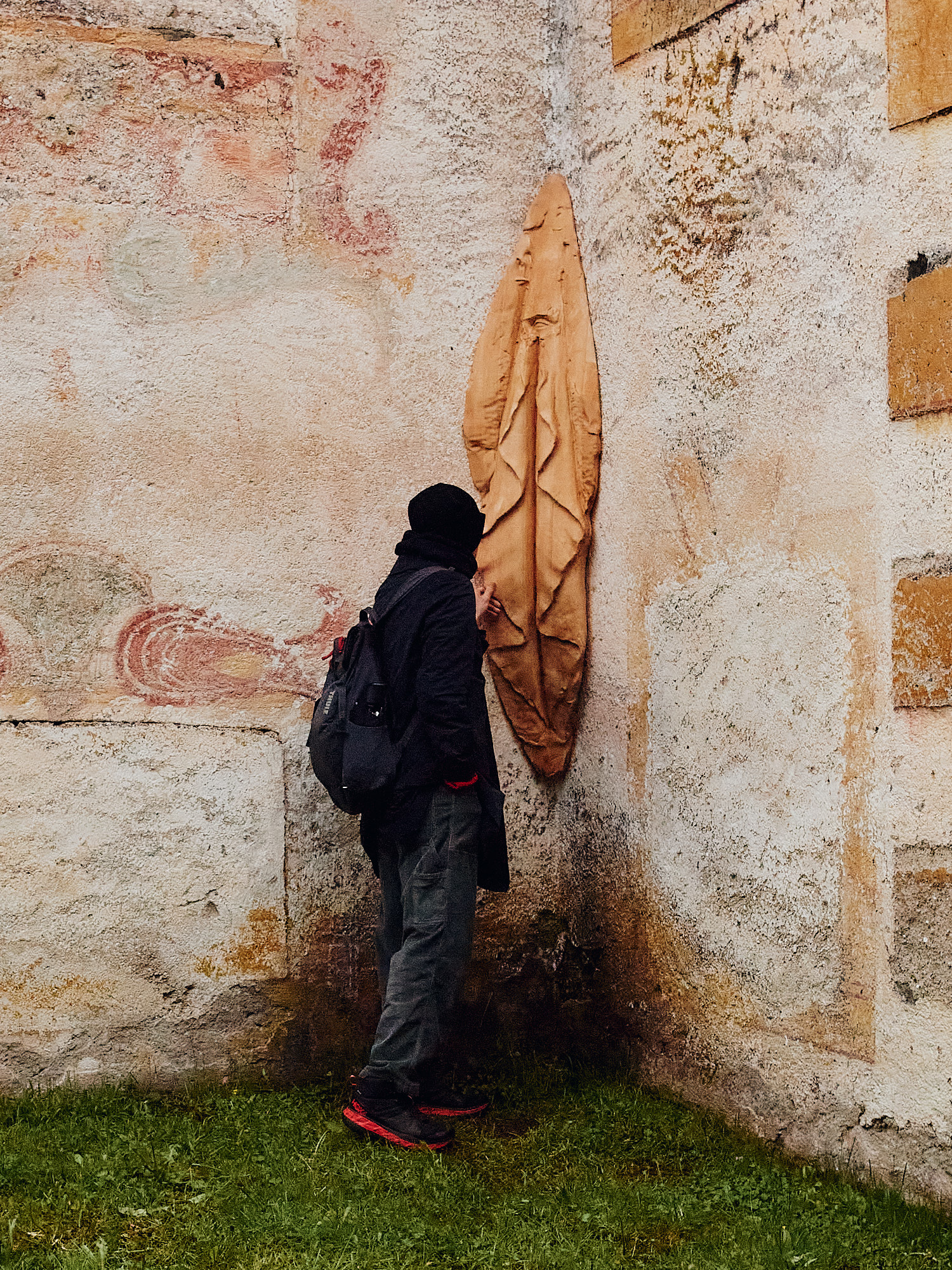

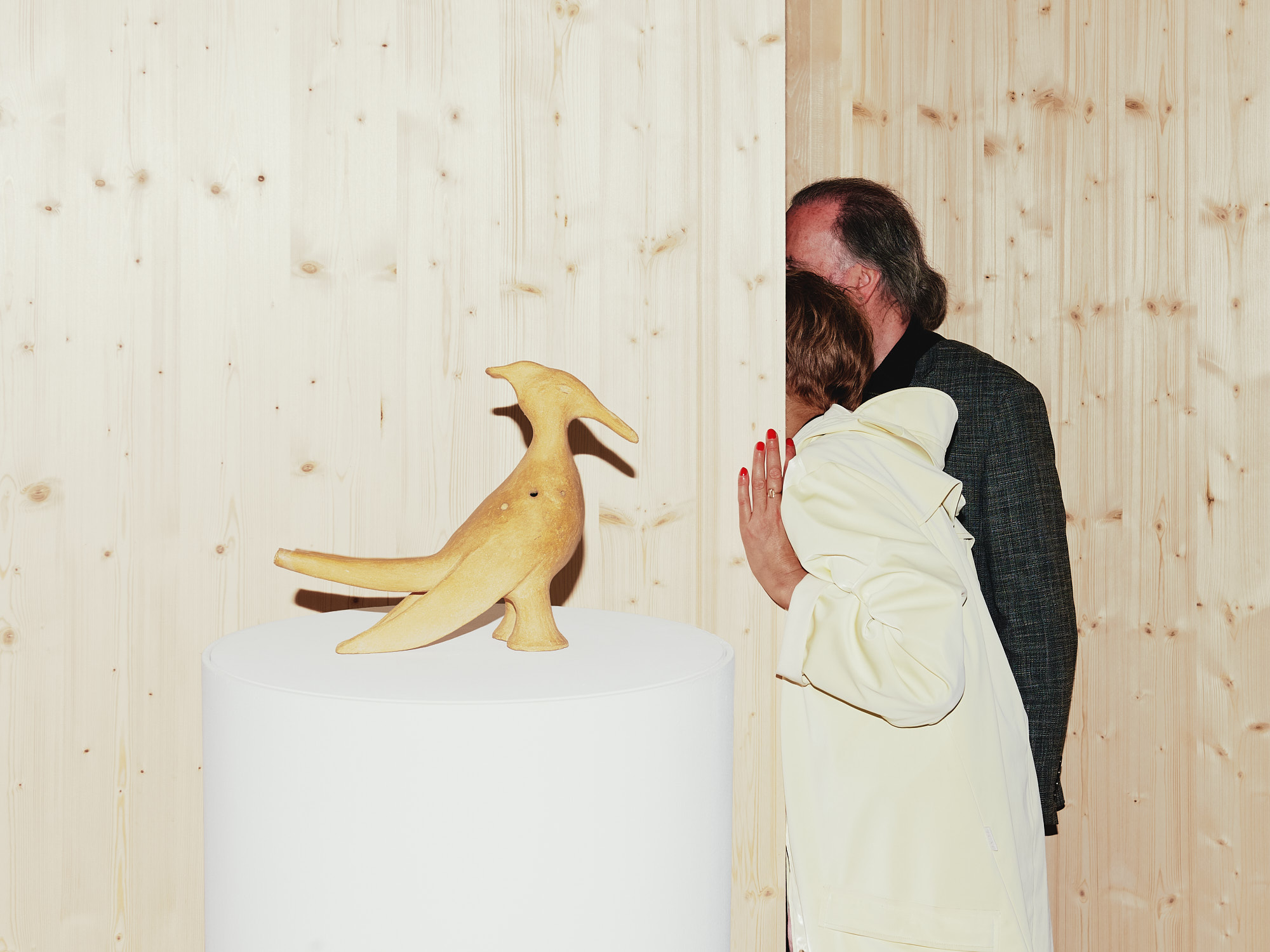

A number of works are located at a cluster of spaces in an
industrial estate outside or Ortisei. Here, there is an eclectic mix of drawing,
site-specific sculpture, installation, and a room packed with video works. An
entrance lobby leading to the Biennale Gherdëina offices is interrupted and
transformed by three animals who seem to have taken over the place and made it
their own. Made of concrete and sculpted to resemble wood by Laurent Le Deunff,
the owl, snail, and crocodile seem to be looking back at those entering the
room. But, closer, they are perhaps tombs or memorials, and we wonder what
happened to these animals, what we did to them.
Several exhibiting artists in this area have connections to the Middle East. This is a deliberate curatorial decision by Lorenzo Giusti who is seeking to consider new connections between the regions, speaking to ancient trading and cultural connections through into the deep time of not only humans but animals and landscape. The Ladin myth that gives the biennial its title was orally communicated, written to paper by Karl Felix Drew in the early 20th century, the author drawing more from Nordic storytelling conventions than the Mediterranean roots of the culture and tale.
Katia Kameli is a French-Algerian artist similarly interested in these cultural connections. Here, she presents a sound sculpture of a bird from a larger choral series of ceramic birds, and video work The Canticle of the Birds. She is poetically considering a story by 12th century Persian writer Farīd al-Dīn ʿAṭṭār who recounted the myth that a thousand birds went on a journey of seven valleys in search of Simorgh, a traditional and mythical creature. Only at the end of the journey, with seven birds surviving, did the creatures realise they were chasing their own reflection.
Yesmine Ben Khelil has made three panels of cardboard stenography depicting the Tunisian mountain, Djebel Boukornine – ‘the mountain with two horns’. The mountain was home to an ancient sanctuary dedicated to the bull, a creature also sacrificed there.
Several exhibiting artists in this area have connections to the Middle East. This is a deliberate curatorial decision by Lorenzo Giusti who is seeking to consider new connections between the regions, speaking to ancient trading and cultural connections through into the deep time of not only humans but animals and landscape. The Ladin myth that gives the biennial its title was orally communicated, written to paper by Karl Felix Drew in the early 20th century, the author drawing more from Nordic storytelling conventions than the Mediterranean roots of the culture and tale.
Katia Kameli is a French-Algerian artist similarly interested in these cultural connections. Here, she presents a sound sculpture of a bird from a larger choral series of ceramic birds, and video work The Canticle of the Birds. She is poetically considering a story by 12th century Persian writer Farīd al-Dīn ʿAṭṭār who recounted the myth that a thousand birds went on a journey of seven valleys in search of Simorgh, a traditional and mythical creature. Only at the end of the journey, with seven birds surviving, did the creatures realise they were chasing their own reflection.
Yesmine Ben Khelil has made three panels of cardboard stenography depicting the Tunisian mountain, Djebel Boukornine – ‘the mountain with two horns’. The mountain was home to an ancient sanctuary dedicated to the bull, a creature also sacrificed there.
Andro Eradze shows a series of photographs of stuffed, wild
animals displayed in museums – turned green to in some way return them to a
nighttime they will never again encounter. Hung from the ceiling are five of the
anthropomorphic masks made by Linda Jasmin Mayer for her performance, turning
the space into a sub aqua seascape.
Talar Aghbashian is a Lebanese-Armenian painter showing a number of canvases scattered around the room, conversing with all the other pieces on show. At first appearing as abstract compositions, forms seem to be trying to show themselves, but it’s not sure if these are representations of the manmade or natural. There is compression of material and content, the world inviting us in is less polarised and clear, muddy but speaking to a past and potential future where our constructions fuse more with those of the world.
Talar Aghbashian is a Lebanese-Armenian painter showing a number of canvases scattered around the room, conversing with all the other pieces on show. At first appearing as abstract compositions, forms seem to be trying to show themselves, but it’s not sure if these are representations of the manmade or natural. There is compression of material and content, the world inviting us in is less polarised and clear, muddy but speaking to a past and potential future where our constructions fuse more with those of the world.





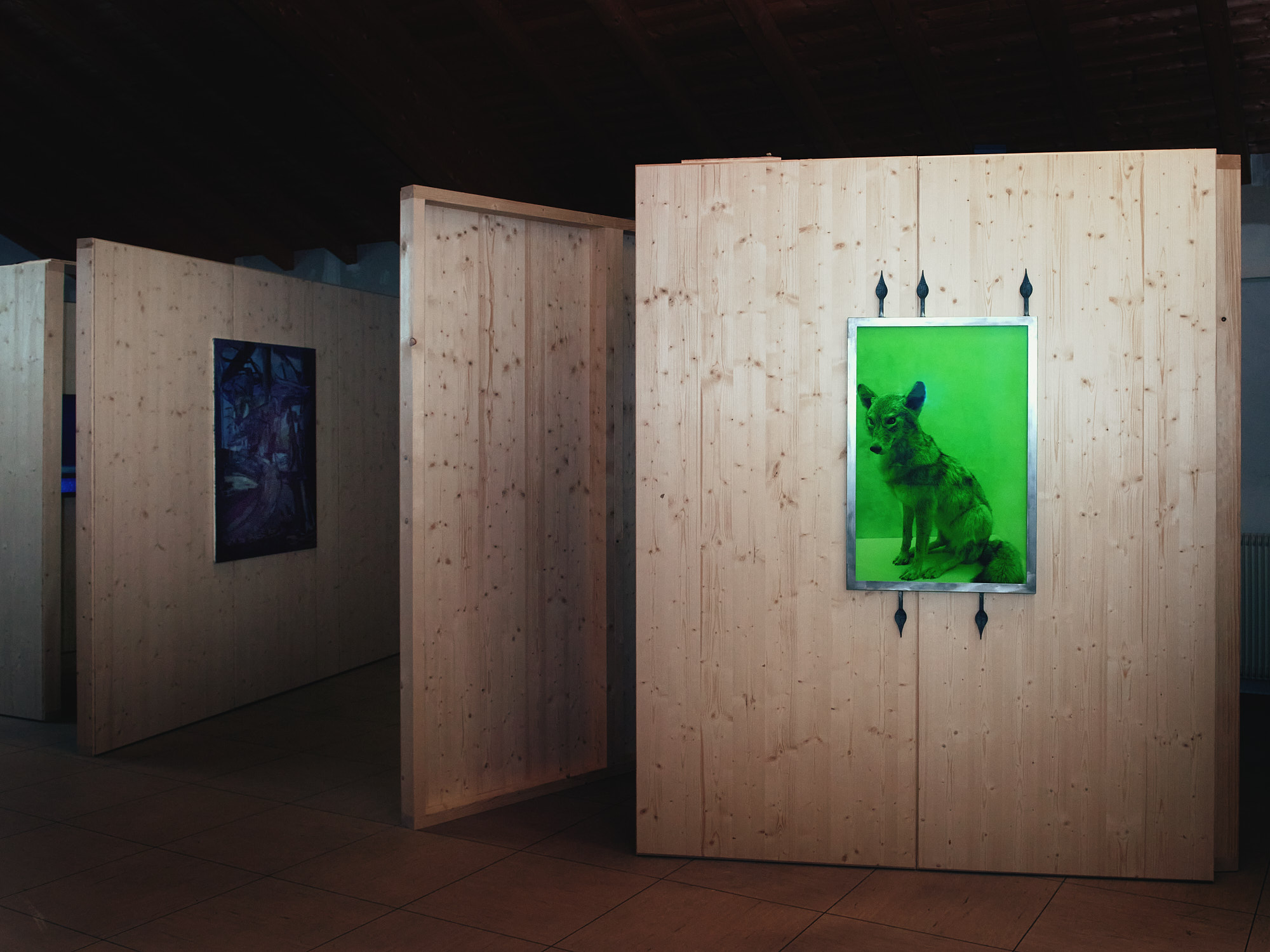



One of the grandest settings for any work in the Biennale Gherdëina
is home to Ingela Ihrman’s skeleton-like wooden sculpture, splayed across a verdant
valley with picturesque views across the mountains. Using wood from trees fallen
in a recent storm having been damaged by the bark beetle epidemic, the artist composed
what reads as an imaginary marine animal, stranded up on the peaks and now
found as archaeological remains. This valley was indeed once under water, the
mountains having started as coral reefs before, 250 million years later, they
rise majestically into the clouds as a seeming antithesis of the deep sea.
It is one of the most poetic and poignant works in the biennial presentation. Delicate and left to sink into the landscape, it speaks not only to the current valley it is within but both the distant-past and distant-future of the place, both times well outside the comparatively temporal moment us humans share this world.
It is one of the most poetic and poignant works in the biennial presentation. Delicate and left to sink into the landscape, it speaks not only to the current valley it is within but both the distant-past and distant-future of the place, both times well outside the comparatively temporal moment us humans share this world.
Biennale Gherdëina is a contemporary art event in Val Gardena, in the heart of the Dolomites, inspired by the unique mix of legends, stories, traditions, nature and languages of Ladinia. The biennial started as a parallel event to MANIFESTA 7 in 2008 to bring a new experience of cultural diversity to the public space of Ortisei. Edition after edition, Biennale Gherdëina has expanded its horizons, embracing neighbouring communities and evolving into an ambitious international project, while always remaining deeply connected to its roots. Set in the breathtaking landscape of the Dolomites and in dialogue with its human and non-human inhabitants, the artworks mostly originate as site-specific projects and are produced on site thanks to the collaboration of Val Gardena artisans and their unique and ancient experience in woodworking. Since 2019, the Biennale organized by Zënza Sëida, a cultural association committed to promoting culture as a central tool for social well-being. Zënza Sëida thus joins the numerous cultural associations in Val Gardena - such as Unika, Circolo artistico e culturale, Tublà da Nives and La Vëta - and together they open up new horizons for the regional contemporary art scene by creating opportunities for the local internationally renowned artists and sculptors among the world's most experienced.
www.biennalegherdeina.it
Lorenzo Giusti (Ph.D) is an Italian art historian and curator, director of GAMeC in Bergamo. He has produced exhibitions and publications dedicated to leading figures in 20th-century art history and curated contemporary art projects in Italy and abroad involving numerous artists from the international scene. His special interests lie in the relationship between historical avant-gardes and contemporary languages as well as between ecological thinking and the visual arts. Curator of the two major retrospectives dedicated to Maria Lai (2015) and Regina Cassolo Bracchi (2021), he is the author of various essays on art of the twentieth and twenty-first centuries.
In 2024 he curated the ninth edition of the Biennale Gherdëina. In 2023 he curated the Modern section of Art Dubai. In 2022 he served on the international jury of the Venice Biennale.
From 2020 to 2022 he was president of AMACI – Associazione dei Musei d’Arte Contemporanea Italiani. In 2020 he conceived the digital platform Radio GAMeC, recognized by UNESCO as one of the most important museum initiatives in the world during the pandemic. From 2019 to 2021 he coordinated the curatorial team of the Back to the Future section of Artissima, Turin. In 2018 he was part of the curatorial team of the Curated by festival in Vienna. In 2017 he curated the international conference Museum at the Post-digital turn at OGR, Turin. In 2016 he was part of the curatorial team of the Third Shenzhen Biennial of Animation (CHN). From 2012 to 2017, he was director of the MAN Museum in Nuoro, Italy.
He has curated solo and group exhibitions in public and private institutions, including Kunsthaus Baselland (Chiara Bersani. Deserters, 2023), the Triennale di Milano (Thea Djordjadze-Fausto Melotti, 2017), FRAC Corse (Nomadisme, 2016) and Palazzo Strozzi (Green Platform, 2008).
www.lorenzogiusti.xyz
Will Jennings is a London based writer, visual artist, and educator interested in cities, architecture, and culture. He has written for the RIBA Journal, the Journal of Civic Architecture, Quietus, The Wire, the Guardian, and Icon. He teaches history and theory at UCL Bartlett and Greenwich University, and is director of UK cultural charity Hypha Studios.
www.willjennings.info
www.biennalegherdeina.it


